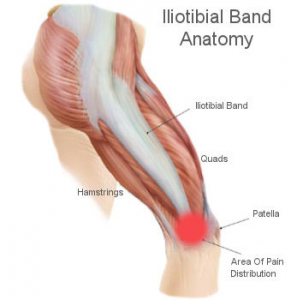
Did you increase your running distance, time or volume during lockdown and now find yourself with outer knee pain?
If you have pain on the outside of your knee, the iliotibial band or ITB as it is commonly referred to could be the culprit. The condition, iliotibial band friction syndrome (ITBFS), is the most common cause of lateral (outer) knee pain in runners accounting for 22% of all running injuries (4). It can be often cause severe pain during exercise, forcing the person to stop the activity.
Not only running though, ITBFS has been associated with sports including cycling, swimming, hockey, soccer, basketball and tennis. (2)
The ITB is thick, tough fascia or tissue that travels down the outside of your leg from the hip to just below the knee. At the hip, the ITB also attaches to the big bottom muscle (the gluteus maximus) and when this muscle contracts it will create tension in the ITB.
The ITB can both help to straighten and bend the knee and is very important in stability of the hip and knee during exercise.

Image credit: https://www.orthopaedicsurgeon.com.sg/patients-education/leg/iliotibial-band-friction-syndrome/
The long bone of the thigh (the femur) has a prominence on the outside of the knee called the lateral femoral condyle. When the leg is straight the ITB sits in front of this condyle and as the knee bends it reaches a point where the ITB will flick over the condyle and sit behind it.
During activities that involve repeated knee bending and straightening, friction is created between the condyle and the end of the ITB. Over time this friction can cause inflammation of the ITB and surrounding structures of the outer knee.
ITBFS is an overuse injury meaning that one of the main causes is a sudden increase in activity levels such as running longer distances or increasing the frequency of exercise. Other possible causes include weakness of the hip and knee muscles, primarily the hip abductors (gluteus medius), tightness in the ITB and surrounding muscles, individual knee and hip alignment, and the way that a person runs (biomechanics). (1)
Wondering if you have ITBFS? Common symptoms include:
If are you experiencing any of these symptoms or any knee pain then don’t worry there is help out there. Recent evidence suggests that a conservative (physio) approach to managing ITBFS is successful in getting people back to work and sport with no pain. (4)
As there are many causes and factors that contribute to developing ITBFS. The Team at the Healthy Body Company can assess your knee pain, discover the root of the problem and develop a tailored treatment plan to get you back on track to achieve your goals.
